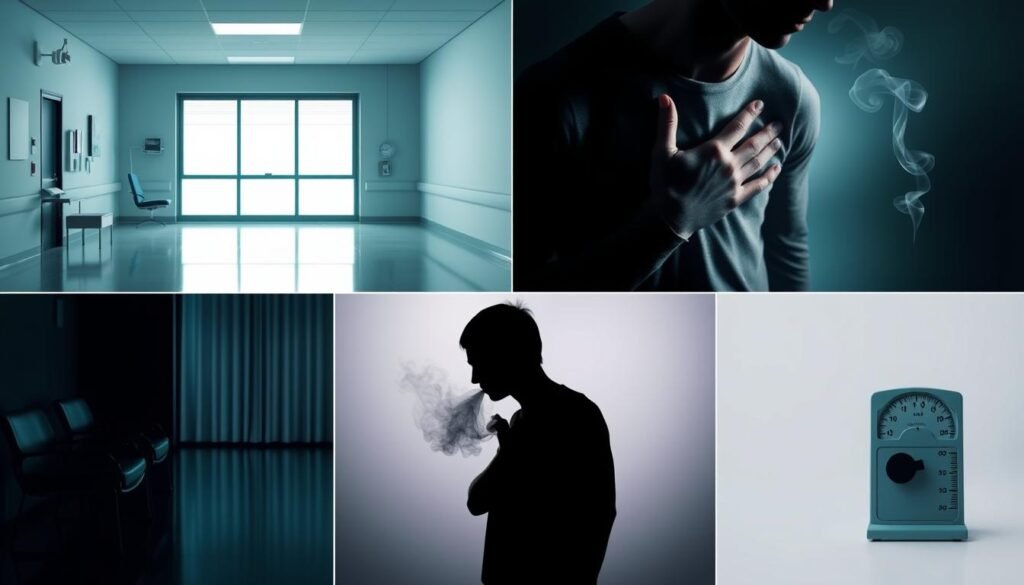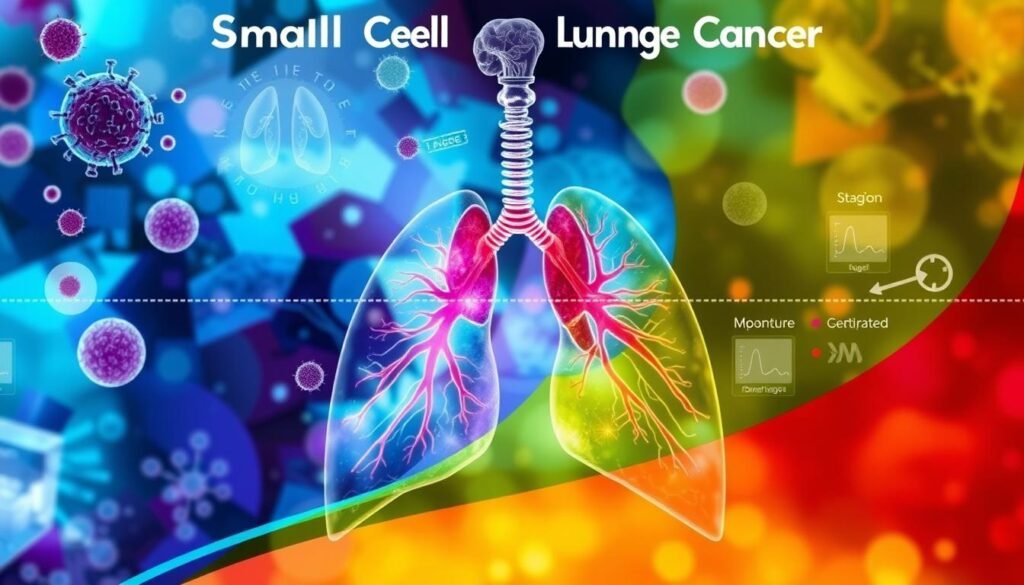Did you know small cell lung cancer (SCLC) is 15% of all lung cancer cases in the US? It is an aggressive cancer, usually tied to smoking. Most people find out they have it in later stages. Spotting it early is key because it can really help survival chances. But, many don’t know the early signs that could help catch it soon.
We wrote this article to explain small cell lung cancer well. You’ll learn about its types, what increases your risk, and how doctors find it. There’s also info on treatments like chemo and immunotherapy. Knowing all this can help you understand SCLC better. It shows why it’s so important to see a doctor if you’re worried.
Key Takeaways
- Small cell lung cancer makes up around 15% of lung cancer cases.
- Coughing and shortness of breath are common early symptoms.
- Smoking is the most significant risk factor for developing SCLC.
- Diagnostic imaging includes chest x-rays and CT scans.
- Chemotherapy remains a primary treatment for SCLC patients.
- Immunotherapy is an emerging treatment for metastatic SCLC.
- Prognosis is generally poor, with a 5-year survival rate of about 5% to 10%.
Understanding Small Cell Lung Cancer (SCLC)
Small Cell Lung Cancer (SCLC) is both unique and aggressive. It represents about 15% of all lung cancer cases. It’s known for growing fast and spreading early. Mostly, heavy smokers get this cancer, making it rare in non-smokers.
Most SCLC cases start in the central breathing tubes. They grow large tumors quickly. This cancer tends to spread fast to vital organs, like the brain and liver. Because of this, survival rates are low, but treatments can help extend life for over a year.
There are two main types of SCLC: small cell carcinoma and combined small cell carcinoma. They’re both considered neuroendocrine tumors. Quick treatment can lead to better results. Treatments include chemotherapy, radiation, and sometimes immunotherapy.
For more info on SCLC, check out understanding SCLC. Research and clinical trials are key to finding new treatments for this cancer.
Types of Small Cell Lung Cancer
Knowing the types of SCLC is crucial for specific treatments and better outcomes. Two main forms are small cell carcinoma and combined small cell carcinoma. Each has unique traits affecting treatment choices.
Small Cell Carcinoma
Small cell carcinoma, also called oat cell cancer, is the most common SCLC type. It grows and spreads quickly, often moving beyond the lungs at diagnosis. Cigarette smoking largely contributes to this issue. Tackling it early is key.
Combined Small Cell Carcinoma
Combined small cell carcinoma includes elements of both small cell and non-small cell cancers. This mix makes deciding on treatment harder. It’s crucial to understand this type well to create effective treatment plans.
The right diagnosis and treatment require accurate ICD-10 codes for small cell lung cancer. Such coding makes sure people get the treatment they need, which helps improve their health outcomes.
| Type of SCLC | Growth Rate | Common Characteristics | Treatment Complexity |
|---|---|---|---|
| Small Cell Carcinoma | Fast | Aggressive, early metastasis | Higher |
| Combined Small Cell Carcinoma | Variable | Combination of small cell and non-small cell features | Very High |
Risk Factors for Small Cell Lung Cancer (SCLC)
It’s important to know the risk factors for SCLC. This knowledge can help us prevent and catch it early. Some habits and places you’ve been can increase your risk. This makes it easier to fight against this tough type of lung cancer.
Smoking and Tobacco Use
Smoking is the top cause of small cell lung cancer. It’s linked to about 80% of the deaths from SCLC. If you’re smoking now, your risk is much higher, by about 42 times, than if you’ve quit. Starting young, especially before 15, makes it worse. Almost everyone with SCLC has smoked at some point.
Occupational Exposures
Working with harmful substances like asbestos or diesel raises your SCLC risk. If your job exposes you to these, and you smoke, your risk jumps. Being in such jobs for a long time, plus smoking, really increases the danger. This highlights how work environments can affect lung cancer risks.
Environmental Factors
Certain things around us can also add to the risk. Air pollution and diesel fumes can up the lung cancer risk a bit. Radon exposure is the second biggest lung cancer cause in the U.S. Having lung cancer in your family or a personal history means a higher risk too. Drinking water with arsenic in it and exposure to radiation for medical reasons are also risk factors. These show how various environmental factors can harm lung health.
| Risk Factor | Impact on SCLC Risk |
|---|---|
| Smoking and Tobacco Use | 80% of deaths; significant odds ratios for current and former smokers |
| Occupational Exposures | Higher risk for those working with asbestos, diesel exhaust, and other carcinogens |
| Environmental Exposures | Radon, air pollution, and arsenic linked to increased SCLC risk |
Signs and Symptoms of Small Cell Lung Cancer (SCLC)
Knowing the signs of SCLC early is key to getting help fast. This cancer type is less common but has clear symptoms. Spotting them early can lead to better treatment outcomes and survival chances.
Coughing and Shortness of Breath
Persistent coughing and shortness of breath are common in SCLC patients. They might cough for a long time. This cough could get worse and might even have blood in it. This is a red flag for seeking urgent medical help. The constant cough can make breathing hard, causing anxiety and discomfort.
Chest Pain and Other Symptoms
Chest pain is another sign, often getting worse with a cough or deep breath. SCLC also shows up as:
- Unexplained weight loss
- Fatigue and weakness
- Hoarseness
- Recurring infections
- Wheezing
Since other respiratory issues share these symptoms, recognizing SCLC early is tough. If you notice these symptoms, it’s crucial to see a doctor fast. Early spotting of SCLC symptoms is important for better treatment results. Learn more about warning signs here.

It’s critical to understand these symptoms. Small cell lung cancer often spreads fast. Most cases are linked to smoking. Being aware of these signs can push smokers to seek help earlier.
Diagnosis of Small Cell Lung Cancer (SCLC)
To find out if someone has SCLC, doctors start with a careful review of the patient’s health history and a physical check-up. It’s important to spot any signs or risks of small cell lung cancer early. After looking at the early signs, the medical team decides what tests are needed next.
Medical History and Physical Examination
During the check-up, doctors ask about smoking, contact with harmful substances, and breathing problems. They also look for clues like swollen glands or weird lung sounds. These steps are key in figuring out if it could be SCLC.
Diagnostic Imaging Techniques
After the first steps, special scans like low-dose chest X-rays and CT scans are used. These scans show the tumor and how far the cancer has spread. MRI and scans like PET scans are also used. They are important for planning the treatment.
Biopsy Procedures
If the scans suggest cancer, a biopsy is done to be sure. This might involve using a fine needle, a slightly bigger needle, or a camera to look inside the lungs. Sometimes, surgery is needed to get a sample. Testing this sample helps doctors figure out the treatment.
| Diagnostic Method | Description | Purpose |
|---|---|---|
| Medical Examination | Assessment of medical history and physical symptoms | Initial evaluation for presence of SCLC |
| CT Scans | Imaging technique to visualize lungs | Determine tumor size and location |
| Biopsy | Procedure to extract lung tissue samples | Confirm presence of cancerous cells |
| MRI | Advanced imaging for detailed views | Assess spread to nearby tissues |
| Nuclear Imaging | Bone scans or PET scans | Evaluate metastatic disease |
Staging of Small Cell Lung Cancer (SCLC)
The staging of SCLC is crucial for figuring out the best treatment and predicting outcomes. It sorts the disease into two groups: limited-stage SCLC and extensive-stage SCLC. In limited-stage, cancer is only in one lung and nearby lymph nodes. About 30% of patients find out they have this stage, which usually means better chances of survival.
Extensive-stage SCLC means the cancer has spread far from where it started, hitting different body parts. This stage’s outlook isn’t as good, with a big drop in the 5-year survival rate. Doctors use detailed tests like scans and biopsies to figure out how far the cancer has spread.
Knowing the differences between these stages helps doctors choose the right treatments. Being found early in screening programs can change outcomes significantly. In fact, 45% of people in these programs get diagnosed early. For more info on how SCLC is staged, check out this link.

Treatment Options for Small Cell Lung Cancer (SCLC)
Small Cell Lung Cancer (SCLC) offers a few main treatments, focusing on chemotherapy and radiation. They adjust based on the cancer’s stage and patient health. Knowing these options helps patients and doctors choose the best way to fight SCLC.
Chemotherapy
Chemotherapy is often the first treatment for SCLC. It works well against this cancer. Many patients see their cancer shrink by up to 70%.
Drugs like Carboplatin and Methotrexate Sodium are key in fighting it. They help lessen tumors and improve symptoms.
Radiation Therapy
Radiation therapy is key, especially in early-stage SCLC. It’s used after chemotherapy to hit cancer cells in the chest. For more advanced cancer, it helps manage symptoms or control cancer spread.
To stop cancer from reaching the brain, doctors might suggest prophylactic cranial radiation.
Targeted Therapy and Immunotherapy
New SCLC treatments are focusing on immunotherapy. This boosts the body’s fight against cancer cells. When paired with chemotherapy, it can better help those with advanced cancer.
Clinical trials are also an option. They offer patients access to cutting-edge treatments that could improve life quality.
Prognosis and Survival Rates
Learning about the prognosis and survival rates for SCLC is key for dealing with this tough lung cancer. There are big differences between limited-stage and extensive-stage SCLC. These differences show why some patients have better outcomes than others.
Differences Between Limited-Stage and Extensive-Stage SCLC
The outlook for SCLC changes a lot between its two stages. For people with limited-stage SCLC, the median survival time is about 17.3 months. But for those with extensive-stage SCLC, the average survival time drops to 8.8 months. This shows how crucial the stage of cancer is for survival rates.
Only 33% of cases are found in the limited stage, while 66% are found in the extensive stage. Catching the cancer early greatly improves the chances of living longer.
Factors Affecting Prognosis
Several things impact a patient’s outlook with SCLC. Key factors include age, health, how well treatment works, and if the patient smoked. Stopping smoking can greatly reduce the risk of dying for these patients.
Patient outcomes also vary based on treatment. Those getting both chemotherapy and radiation therapy tend to do better than those with chemotherapy alone. Knowing these factors helps tailor the best treatment plans.
| Stage | Median Survival Rate | 5-Year Survival Rate |
|---|---|---|
| Limited-Stage SCLC | 15-20 months | 27% |
| Extensive-Stage SCLC | 8-13 months | 3% |
For more detailed survival statistics, you can visit this survival rates resource. This information is important for patients and doctors to decide on the best treatment and care.

Supportive Care for Patients with Small Cell Lung Cancer (SCLC)
Supportive care for SCLC patients aims to improve their life quality. It focuses on managing SCLC symptoms, reducing pain, and offering psychological help. Palliative care is key, taking care of the body, emotions, and social needs.
Since small cell lung cancer spreads quickly, total care is critical. Patients deal with physical problems, emotional stress, and poor nutrition. Thus, supportive care for SCLC patients has several important parts:
- Palliative care to ease symptoms like pain, nausea, and tiredness.
- Psychological support with counseling or groups to help with the emotional toll of the disease.
- Nutritional advice to keep patients well-fed during their treatment.
- Custom medication and therapy plans for symptom control.
Talking often with healthcare providers is vital. It allows for care plan updates and quick problem-solving.
Caring for a patient’s mental and physical health deeply affects their experience with small cell lung cancer. Being educated about care choices gives them power over their decisions.
| Supportive Care Components | Description |
|---|---|
| Palliative Care | Focuses on relieving symptoms and improving the patient’s quality of life. |
| Psychological Support | Offers counseling and support systems for emotional well-being. |
| Nutritional Counseling | Assists in maintaining nutritional health during treatment cycles. |
| Symptom Management | Personalized approaches to mitigate symptoms effectively. |
Conclusion
Small Cell Lung Cancer (SCLC) is a tough challenge mainly because it spreads fast and early. Every year, around 232,000 people globally are found to have it. This accounts for 11% of all lung cancer cases. Knowing about its symptoms, risk factors, and treatments is crucial for better patient outcomes. It’s important to catch this disease early to fight it effectively.
The way we treat SCLC is getting better with time. Now, it’s clear that a team approach is best. This team includes using chemotherapy, radiation, and new targeted therapies. Even though a lot of people get SCLC, especially smokers, new treatments are offering hope. Yet, the reality is tough. Most patients live less than a year after diagnosis. This fact shows why we must keep looking for new treatments.
In the end, we need everyone to join in fighting SCLC. As more people get lung cancer, especially in developing places, we have to act fast. We must focus on raising awareness, researching, and creating new treatments. This effort will help lessen the impact of SCLC on those affected in the years to come.